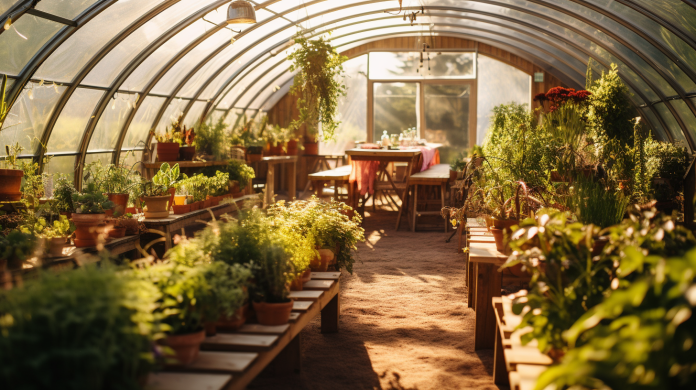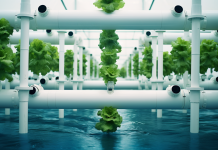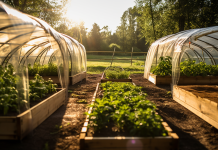Welcome to our brief guide on Polytunnel Herbs – Setup and Preparation. In this article, we will provide you with insights on preparing the soil, choosing the most suitable herbs, designing an efficient layout, and maintaining your polytunnel herbs.
Whether you are a seasoned gardener or a beginner, this guide may help equip you with the knowledge and techniques to create a thriving herb garden within your polytunnel.
Preparing the Soil for Herb Planting
To ensure optimal growth and health of your herb plants, it is essential to properly prepare the soil before planting them in your polytunnel. Here are some steps you can take to improve soil fertility and implement organic pest control:
- Add organic matter: Incorporate compost, well-rotted manure, or leaf mold into the soil to increase its nutrient content and improve drainage.
- Adjust pH levels: Test the soil and adjust the pH levels if necessary. Most herbs prefer a slightly acidic to neutral pH range of 6.0 to 7.0.
- Mulch the soil: Apply a layer of organic mulch around your herb plants to conserve moisture, suppress weed growth, and provide additional nutrients as it breaks down.
- Implement companion planting: Consider planting herbs that have natural pest-repellent properties, such as basil, rosemary, or mint, alongside your chosen herbs to deter pests and promote overall plant health.
- Practice crop rotation: Rotate your herb plants annually to prevent the buildup of pests and diseases in the soil.
Choosing the Best Herbs for Your Polytunnel
When selecting herbs for your polytunnel, consider both culinary and medicinal varieties to create a diverse and functional herb garden. There are numerous herb varieties to choose from, each with its own unique flavor profile and health benefits.
When making your selection, it is important to consider the growing conditions in your polytunnel. Some herbs, such as basil and parsley, prefer warm and sunny conditions, while others, like mint and lemon balm, thrive in partially shaded areas. Additionally, consider the moisture levels required by different herbs.
For example, rosemary and thyme prefer drier soil, while herbs like coriander and chives thrive in more moisture-retentive soil. By carefully selecting a range of herbs that are suited to the growing conditions in your polytunnel, you can create a vibrant and productive herb garden.
Designing the Layout of Your Herb Garden
Having a well-planned and organized layout is essential for maximizing the space and functionality of your herb garden in the polytunnel. When designing the layout of your herb garden, consider the following:
- Herb Garden Design:
- Divide the garden into distinct areas for different types of herbs, such as culinary herbs, medicinal herbs, or fragrant herbs.
- Use raised beds or containers to create defined planting areas and improve drainage.
- Companion Planting:
- Plant herbs that have beneficial relationships with each other. For example, basil and tomatoes thrive when planted together.
- Avoid planting herbs that are incompatible or compete for resources. For instance, sage and cucumbers should be kept apart.
Maintaining and Caring for Your Polytunnel Herbs
Regularly watering and fertilizing your polytunnel herbs, as well as monitoring for pests and diseases, are crucial tasks in maintaining and caring for your herb garden.
Proper watering is essential to keep your herbs healthy and thriving. Ensure that the soil is consistently moist, but not waterlogged, as excessive moisture can lead to root rot.
Fertilize your herbs every few weeks with a balanced fertilizer to provide them with the necessary nutrients.
Additionally, it is important to regularly inspect your plants for signs of pests and diseases. Implementing pest control measures, such as introducing beneficial insects or using organic insecticides, for example:
Neem Oil
Source: Extracted from the seeds of the neem tree.
Uses: Effective against a wide range of pests and fungi. It acts as a repellent and disrupts the life cycle of insects.
Garlic and Chili Sprays
Source: Made from garlic and chili peppers.
Uses: Acts as a repellent against a variety of pests due to its strong odor and taste.
Pyrethrum
Source: Extracted from the flowers of certain chrysanthemum species.
Uses: Attacks the nervous systems of pests, causing immediate paralysis.
Insecticidal Soaps Vs Dishwashing Liquid Mix
1. Chemical Composition:
Insecticidal Soaps: These are specifically formulated to control pests. They contain fatty acids that dissolve the outer layer of pests, leading to dehydration and death of the insect.
Dishwashing Liquids: These are designed to remove grease and food particles and might not have the necessary components to effectively control pests.
2. Safety:
Insecticidal Soaps: Generally safer for plants when used as directed, and they are designed to minimize harm to beneficial insects and the surrounding environment.
Dishwashing Liquids: May contain harsh chemicals, dyes, and fragrances that could be harmful to plants and beneficial insects.
3. Effectiveness:
Insecticidal Soaps: Specifically targeted towards pests and their life stages, making them more effective.
Dishwashing Liquids: Might not be as effective against pests and may require more frequent application, leading to increased plant stress.
4. Residue:
Insecticidal Soaps: Leave minimal residue on plants, reducing the risk of plant damage.
Dishwashing Liquids: Might leave unwanted residues on plants, affecting their health and the soil.
5. Plant Sensitivity:
Insecticidal Soaps: Designed to be gentle on plants, reducing the risk of causing harm, such as leaf burn.
Dishwashing Liquids: Not formulated for plants, and their use might lead to adverse reactions, such as discoloration or leaf burn.
Conclusion
- Choose a location with ample sunlight exposure and avoid shaded areas or tall plants that may cast shadows.
- Incorporate organic matter into the soil and adjust pH levels if necessary.
- Implement companion planting and practice crop rotation to prevent pests and diseases.
- Consider both culinary and medicinal herb varieties and select herbs based on their growing conditions and moisture requirements.
Proper maintenance and care are also necessary for successful herb growth in a polytunnel. Harvesting and preserving your polytunnel herbs at the right time will ensure the best flavor and longevity of your herbs. By following these steps, gardeners can create a thriving herb garden within a polytunnel environment.
Please see our supporting article:
Future Plans and Expanding Your Herb Garden



